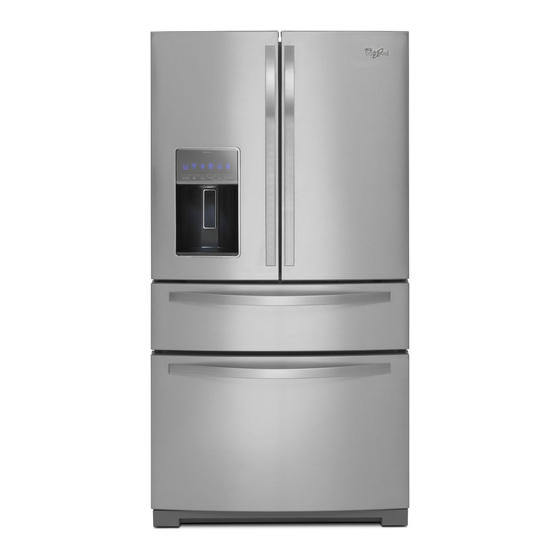Whirlpool WRX988SIBW 설치 지침 및 사용 설명서 - 페이지 18
{카테고리_이름} Whirlpool WRX988SIBW에 대한 설치 지침 및 사용 설명서을 온라인으로 검색하거나 PDF를 다운로드하세요. Whirlpool WRX988SIBW 48 페이지. Bottom mount refrigerator
Whirlpool WRX988SIBW에 대해서도 마찬가지입니다: 에너지 매뉴얼 (1 페이지)

GENERAL OPERATION
Exterior drawer control
not lit/unresponsive
Refrigerator
seems noisy
Temperature
is too warm
Temperature is too cold
in the refrigerator/
crisper
Temperature is too
warm/cold in the
exterior drawer
Interior moisture buildup
18
Possible Causes and/or Recommended Solutions
The refrigerator is in Cooling Off mode - Exit Cooling Off mode. See "Using the Control(s)" in the
User Instructions or User Guide.
The refrigerator controls' initialization process did not complete successfully - Unplug the
refrigerator, wait 5 seconds. Plug in the refrigerator, and wait 30 seconds before opening the doors
or drawers, or touching the control panel.
The drawer front was recently removed - Make sure the temperature control wires have been
properly reconnected. See "Remove and Replace Drawer Fronts."
The compressor in your new refrigerator regulates temperature more efficiently and uses less energy
than older models. During various stages of operation, you may hear normal operating sounds that are
unfamiliar.
The following noises are normal:
Buzzing/Clicking - Heard when the water valve opens and closes to dispense water or fill the ice
maker. If the refrigerator is connected to a water line, this is normal. If the refrigerator is not
connected to a water line, turn off the ice maker.
Repetitive Clicking - Dual evaporator valve regulating the cooling operation.
Cracking/Clatter - Heard when ice is ejected from the ice maker mold and then falls into the ice
storage bin.
Popping - Heard when the inside walls contract/expand, especially during initial cool-down.
Hissing/Dripping - Flow of refrigerant, or flow of oil in the compressor.
Pulsating/Whirring - Heard when the fans/compressor adjust to optimize performance during
normal operation.
Rattling - Heard when water passes through the water line, or due to the flow of refrigerant. Rattling
may also come from items placed on top of the refrigerator.
Water running or gurgling - Heard when ice melts during the defrost cycle and water runs into the
drain pan.
Sizzling - Heard when water drips onto the heater during the defrost cycle.
Vibration - The refrigerator may not be steady. Adjust the leveling screws and lower the leveling foot
until it is firmly against the floor. See "Refrigerator Leveling, Door Closing and Alignment."
New installation - Following installation, allow 24 hours for the refrigerator and freezer to cool
completely.
NOTE: Adjusting the temperature control(s) to the coldest setting will not cool either compartment
(refrigerator or freezer) more quickly.
Cooling is turned off - Turn on cooling. See "Using the Controls" in the User Instructions or User
Guide.
Doors are opened often or not closed completely - This allows warm air to enter the refrigerator.
Minimize door openings, keep the doors fully closed, and make sure both doors are properly sealed.
Air vents are blocked - Remove items that are immediately in front of the vents.
Large amount of warm food recently added - Allow several hours for the refrigerator to return to
its normal temperature.
Controls are not set correctly for the surrounding conditions - Adjust the controls to a colder
setting. Check the temperature again in 24 hours.
Controls are not set correctly for the surrounding conditions - Adjust the controls to a warmer
setting. Check the temperature again in 24 hours.
Ice storage bin is not in the correct position - See "Ice Maker and Ice Storage Bin" in the User
Instructions or User Guide.
Air vents are blocked - Remove items that are immediately in front of the vents.
Control is not set correctly for the items stored in the drawer - Adjust the temperature setting.
See "Temperature Controlled Exterior Drawer" in the User Instructions or User Guide.
NOTE: Some moisture buildup is normal. Clean with a soft dry cloth.
Room is humid - A humid environment contributes to moisture buildup. Only use the refrigerator in
an indoor location, with as little humidity as possible.
Doors are opened often or not closed completely - This allows humid air to enter the refrigerator.
Minimize door openings, keep the doors fully closed, and make sure both doors are properly sealed.
